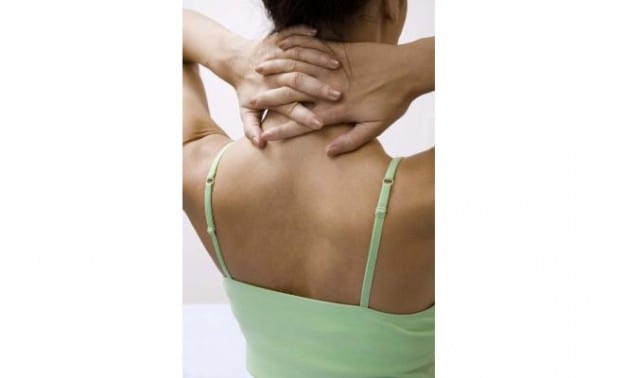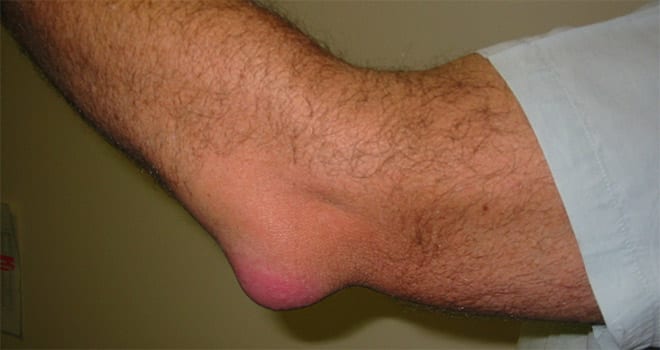
Bursitis, tendonitis and other soft tissue syndromes
Myofascial pain is caused by a non-inflammatory disorder that causes localised pain, stiffness and trigger points.
Myofascial pain is defined as pain originating from myofascial trigger points in skeletal muscle. It is common in regional musculoskeletal pain syndromes, either alone or in combination with another pain generator.
It has 3 basic components:
- a palpable band in the affected striated muscle. It produces tension in the muscle by contraction of the palpable nodule. It is not visible to the naked eye, but can be seen if proper muscle scanning is performed at the site of the muscle of greatest relaxation.
- trigger points: hypersensitive area that is identified by palpation and reproduces the local pain and the pain referred to at a distance by the patient, which is the source of the pain. There are two types of trigger points, active and latent. Active trigger points are the direct cause of pain and latent trigger points produce dysfunction when muscle movements are performed.
- pain. It is a regional pain of muscular origin localised in a muscle or muscle group.
Proper assessment and management of myofascial pain is an important part of musculoskeletal rehabilitation, and of regional axial and limb pain syndromes.
The conventional definition of myofascial pain syndrome is characterised by regional pain from hyperirritable sites within tight bands of skeletal muscle known as myofascial trigger points.
Myofascial pain can result from direct or indirect trauma, spinal pathology, exposure to cumulative and repetitive stress, postural dysfunction or physical deconditioning.
Treatment of the underlying aetiology is currently the most accepted strategy for myofascial pain therapy.. If left untreated, trigger points can become active and myofascial pain syndrome can persist.
Bursitis
It occurs when the bursae become inflamed causing pain.. Bursae are a kind of shock-absorbing fluid sacs found in places where there are points of friction, such as muscles, tendons or bones. They help in the normal movement of the joints by preventing friction. We have bursae all over the body, but bursitis usually occurs in the shoulders, knees, hips, pelvis, toes, elbows and heels.

We will know we have bursitis when we feel pain when carrying out certain normal everyday movements. Another symptom that can occur is fever.
Bursitis can be acute, where the joint has a reddish colour and a higher temperature than the rest of the body. It is usually caused by an infection or gout. There is also chronic bursitis, which can be caused by a previous acute bursitis or by repeated injuries to a joint. It causes muscle atrophy and motor weakness.
For the treatment of bursitis, it is best to avoid overexertion and the application of cold or heat and splints.
Tendinitis
Like bursitis, tendonitis causes swelling in the muscles and bones. It also occurs most commonly in the same areas as bursitis, i.e. shoulders, elbows, wrists, ankles, hips or knees. But in this case affects tendons, which are flexible bands of tissue that connect muscles to bones.. Tendons can be small, such as those in the hand or ankle, or large, such as the Achilles tendon in the heel. Tendons help create movement by causing muscles to push bones in different ways. Tendonitis can be defined as the intense inflammation of a tendon.
Tendonitis usually occurs when there has been repeated injury to a particular area, such as the knee or ankle. Tendons wear out over time.
Both bursitis and tendonitis are more likely to occur when the same movements are performed every day or too much force is put on the joints.
Other soft tissue syndromes
There are other soft tissue syndromes that are forms of tendinitis that are named according to the sport in which they are most likely to occur.

- Tennis elbow and golfer's elbowTennis elbow occurs because of tendon injury the outer elbow and golfer's elbow due to injury to the inner tendon. The pain manifests itself in the elbow, but may spread to the arm or forearm.
- Shoulder impingementThere are two types of tendinitis affecting the shoulder. In biceps tendinitis, the affected part is the biceps, the muscle at the front of the arm that holds the bone inside the socket of the shoulder joint, and in rotator cuff tendinitis, the affected part is the uppermost part of the shoulder and arm. The rotator cuff is a set of muscles that attach the arm to the shoulder blade or scapula. This 'cuff' allows the arm to lift and rotate. It is when the rotator cuff is compressed that shoulder impingement occurs. This can be caused by sports that involve heavy use of the shoulder, by rheumatoid arthritis or for work that requires reaching overhead.
- Jumper's kneeIt is so called because it often affects young basketball players. But it can also affect older people whose tendons are less flexible and weakened. Or people who inflame or tear tendons if they abuse activities such as dancing, jogging or cycling.
- Achilles tendonitisAchilles tendon: the Achilles tendon, which is the tendon that connects the calf to the back of the heel. This is when this tendon becomes inflamed, stretched or torn. When climbing stairs, for example, this injury can occur. In athletes, Achilles tendonitis most often occurs in sprinting or jumping. In football or basketball, an Achilles tendon injury means the end of the season for the athlete. Inflammation of the Achilles tendon can also be a long-term condition.
Treatment of bursitis and tendonitis
The purpose of the treatment is to heal the bursa, or injured tendon. The first step is to reduce pain and inflammation, which can be achieved by rest, immobilisation with a tight bandage, elevation of the affected area or by taking anti-inflammatory medication. Ice may be a good initial measure, but in chronic injuries it will not be of much help.
There are other treatments such as electric currents, exercises and stretching massages.
If the condition does not improve, surgery may be performed to repair the damage and relieve pressure on the tendons and bursae.
There are currently new regenerative medicine treatments using platelet-rich plasma, in which Biosalud is a pioneering centre in Spain.


2 thoughts on “¿Qué es el síndrome del dolor miofascial?”
More of a question than a comment. My son was diagnosed with myofascial retraction in the throat area. He has been complaining of a permanent tightening for a year now. At the moment physiotherapy is not working. Is there a surgical treatment for this problem?
Comments are closed.